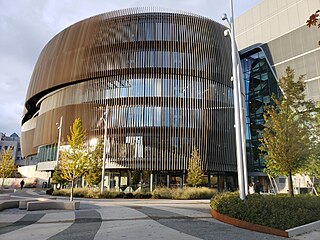
The State University of New York at Buffalo, commonly called the University at Buffalo (UB) and sometimes called SUNY Buffalo, is a public research university with campuses in Buffalo and Amherst, New York. The university was founded in 1846 as a private medical college and merged with the State University of New York system in 1962. It is one of the two flagship institutions of the SUNY system. As of fall 2020, the university enrolled 32,347 students in 13 schools and colleges, making it the largest and most comprehensive public university in the state of New York.

Chemnitz University of Technology is a public university in Chemnitz, Germany. With over 9,000 students, it is the third largest university in Saxony. It was founded in 1836 as Königliche Gewerbschule and was elevated to a Technische Hochschule, a university of technology, in 1963. With approximately 1,500 employees in science, engineering and management, Chemnitz University of Technology is among the most important employers in the region.
The Engineering Campus is the colloquial name for the portions of campus surrounding the Bardeen Quadrangle and the Beckman Quadrangle at the College of Engineering at the University of Illinois at Urbana–Champaign. It is an area of approximately 30 square blocks, roughly bounded by Green Street on the south, Wright Street on the west, University Avenue on the north, and Gregory Street on the east.

B+H Architects or BH Architects is a Canadian architectural and engineering firm headquartered in Toronto, Ontario. The firm was founded in 1953 by Sidney Bregman and George Hamann.

The Danforth Campus is the main campus at Washington University in St. Louis. Formerly known as the Hilltop Campus, it was officially dedicated as the Danforth Campus on September 17, 2006, in honor of William H. Danforth, the 13th Chancellor of the University, the Danforth family and the Danforth Foundation. Distinguished by its collegiate gothic architecture, the 169-acre (0.68 km2) campus lies at the western boundary of Forest Park, partially in the City of St. Louis. Most of the campus is in a small enclave of unincorporated St. Louis County, while all the campus area south of Forsyth Boulevard is in suburban Clayton. Immediately to the north across Forest Park Parkway is University City.

The Christopher W. Klaus Advanced Computing Building is a three-story academic building at the Georgia Institute of Technology that houses a portion of its College of Computing, College of Engineering, and related programs.

The Hillsboro Civic Center is a government-built, mixed-use development in downtown Hillsboro, Oregon, United States. The development includes the city hall for the county seat of Washington County, located west of Portland, Oregon. Covering 6 acres (24,000 m2), the Civic Center has a total of over 165,000 square feet (15,300 m2) in the complex. The total of six stories for the main structure makes the building the tallest in the city, tied with Tuality Community Hospital. In addition to government offices, the Civic Center includes retail space, public plazas, and residential housing. The complex was built to centralize city government functions under one roof.
Innovista is the economic development arm of the University of South Carolina.
Green building on college campuses is the purposeful construction of buildings on college campuses that decreases resource usage in both the building process and also the future use of the building. The goal is to reduce CO2 emissions, energy use, and water use, while creating an atmosphere where students can be healthy and learn. Universities across the country are building to green standards set forth by the USGBC, United States Green Building Council. The USGBC is a non-profit organization that promotes sustainability in how buildings are designed and built. This organization created the Leadership in Energy and Environmental Design (LEED) rating system, which is a certification process that provides verification that a building is environmentally sustainable. In the United States, commercial and residential buildings account for 70 percent of the electricity use and over 38 percent of CO2 emissions. Because of these huge statistics regarding resource usage and emissions, the room for more efficient building practices is dramatic. Since college campuses are where the world's future leaders are being taught, colleges are choosing to construct new buildings to green standards in order to promote environmental stewardship to their students. Colleges across the United States have taken leading roles in the construction of green building in order to reduce resource consumption, save money in the long run, and instill the importance on environmental sustainability on their students. It is a better way to motivate new generation to live a sustainable life.
Flad Architects is a national architectural firm with offices in Madison, Wisconsin; Atlanta, Georgia; Gainesville and Tampa, Florida; Raleigh, North Carolina; San Francisco, California, Seattle, Washington; and New York, New York. In addition to architectural design, Flad offers interior design, landscape architecture, master planning, strategic planning, structural engineering, and sustainable design services. The firm is involved in multiple markets and building types including: corporate, healthcare, higher education, science and technology, and the federal government.

The G. Wayne Clough Undergraduate Learning Commons, commonly referred to by its acronym CULC, is an academic building on the main campus of the Georgia Institute of Technology. The five-story, 220,000 sq ft (20,000 m2) building houses classrooms, science laboratories, academic services, commons areas, and is managed by and connected to the Georgia Tech Library. Named in honor of President Emeritus G. Wayne Clough, the Clough Commons cost $85 million and opened in the fall of 2011.
The John A. Swanson Science Center, also known as the Swanson Science Center is an academic building on the campus of Washington & Jefferson College. It was completed in February 2010 and was named after John A. Swanson, an engineer and businessman on the Board of Trustees, who donated $10 million towards its construction. This 47,500 square feet (4,410 m2) facility houses classrooms for Chemistry, Physics, Biophysics and Biochemistry and was designed to match its neighboring historic campus architecture. Its learning facilities include wet and dry teaching laboratories, faculty and student research labs, and a multi-disciplinary lab designed for non-science majors.

Michigan Technological University's campus sits on 925 acres on a bluff overlooking Portage Lake.
The University of Toronto Mississauga is a satellite campus of the University of Toronto. It is in Mississauga, Ontario, Canada about 33 kilometres west of the main St. George campus. It was formerly called the Erindale College but was later changed to the University of Toronto Mississauga (UTM). The campus has eight main educational buildings: the Maanjiwe nendamowinan Building, Deerfield Hall, the William G. Davis Building, the Kaneff Centre and Blackwood Gallery, the Recreation, Athletic, and Wellness Centre, the Hazel McCallion Academic Learning Centre which holds UTM's library, the Instructional Building, and the new Terrence Donnelly Health Sciences Complex for the Mississauga Academy of Medicine. The campus also houses 3 residence halls: Erindale Hall, Roy Ivor Hall, and Oscar Peterson Hall.
The University at Buffalo School of Engineering and Applied Sciences, or UB Engineering, is the largest public engineering school in the state of New York and is home to eight departments. Established in 1946, UB Engineering is ranked 59th by U.S. News & World Report and has an annual research expenditure of $72 million.

DPR Construction is a commercial general contractor and construction management firm based in Redwood City, California. The privately-held, employee-owned company has 30 offices throughout the United States and specializes in technically complex and sustainable projects for the advanced technology/mission-critical, life sciences, healthcare, higher education and commercial office markets. International offices located in Europe and Asia.
Danto Engineering Development Center is an academic learning center is attached to the College of Engineering building at Wayne State University. It is Located at 5050 Anthony Street in Detroit, Michigan on the Wayne State main campus, and it is across the street from the Physics Building.

Venu Govindaraju is an Indian-American whose research interests are in the fields of document image analysis and biometrics. He presently serves as the Vice President for Research and Economic Development. He is a SUNY Distinguished Professor of Computer Science and Engineering, School of Engineering and Applied Sciences at the University at Buffalo, The State University of New York, Buffalo, NY, USA.

The College of Engineering is a college within the University of Notre Dame. The Dean of the College of Engineering is Patricia J. Culligan, Ph.D. Its graduate school for Engineering is ranked #47 in the USA and #15 for undergraduate.

The Interdisciplinary Science and Engineering Complex (ISEC) is a 234,000 square-foot building at Northeastern University designed for collaborative research, laboratory access, and classroom learning. The building is located on the University's central campus at 805 Columbus Ave, Boston, Massachusetts. The building initially opened on April 3, 2017.












